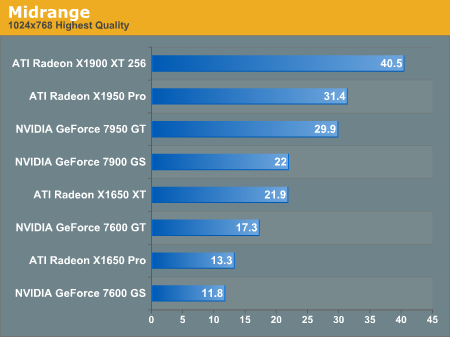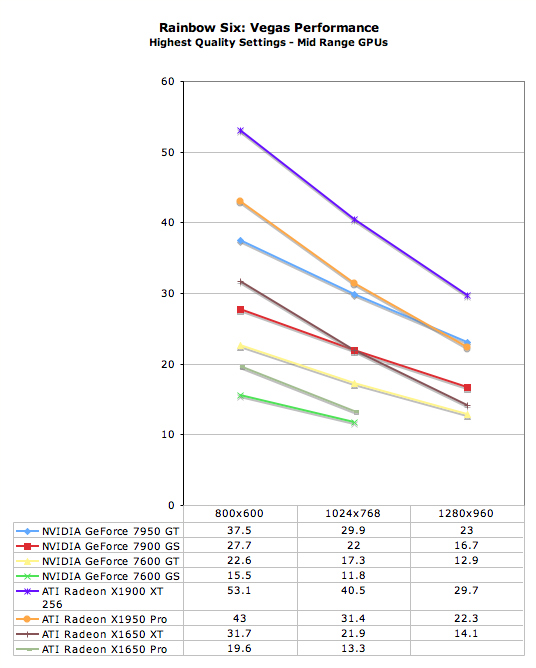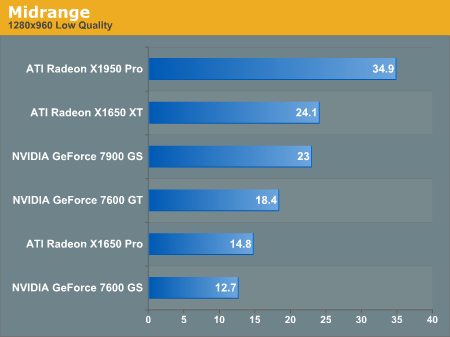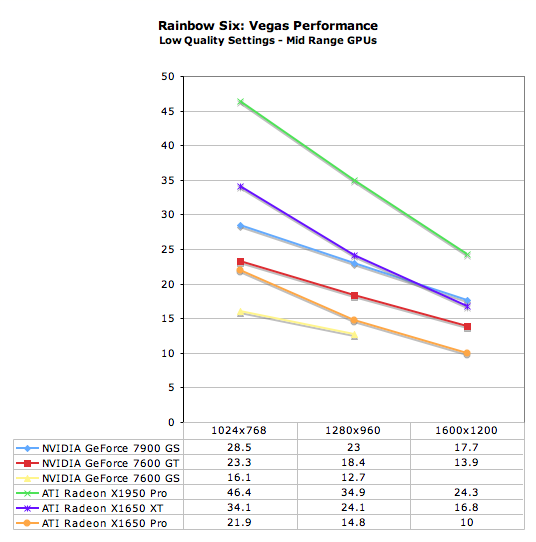Rainbow Six: Vegas: A Performance Analysis
by Josh Venning on December 25, 2006 6:00 AM EST- Posted in
- Gaming
Mainstream/Midrange Performance


Rainbow Six: Vegas is a graphically intensive game, but as we said, we didn't have to play it at the highest resolution for it to look good. 1024x768 isn't a bad compromise to get a good balance of performance and graphics out of the game. When we step down to the midrange cards, this is really the most that any of these cards can handle at the higher detail settings. The X1650 XT is your best choice for playing this game at 1024x768 at the highest settings, but some overclocking might still be necessary. The slightly higher price of the X1650 XT (if you can find it right now) would still be a better choice for this game than the 7600 GT - its direct competitor from NVIDIA - because of the extra performance we see here.
Now let's look at how these cards perform with the same benchmark at the lower quality settings.


We can see that with NVIDIA, the amount of performance gain we generally see from turning the graphics quality settings down varies from around 40% to 45%. With ATI however, the performance gains are around 55% to 60%. This means obviously we'll have a better chance of picking up more performance and playing the game at a higher resolution with ATI cards by turning the quality settings down.


Rainbow Six: Vegas is a graphically intensive game, but as we said, we didn't have to play it at the highest resolution for it to look good. 1024x768 isn't a bad compromise to get a good balance of performance and graphics out of the game. When we step down to the midrange cards, this is really the most that any of these cards can handle at the higher detail settings. The X1650 XT is your best choice for playing this game at 1024x768 at the highest settings, but some overclocking might still be necessary. The slightly higher price of the X1650 XT (if you can find it right now) would still be a better choice for this game than the 7600 GT - its direct competitor from NVIDIA - because of the extra performance we see here.
Now let's look at how these cards perform with the same benchmark at the lower quality settings.


We can see that with NVIDIA, the amount of performance gain we generally see from turning the graphics quality settings down varies from around 40% to 45%. With ATI however, the performance gains are around 55% to 60%. This means obviously we'll have a better chance of picking up more performance and playing the game at a higher resolution with ATI cards by turning the quality settings down.










32 Comments
View All Comments
fuhsiang - Monday, December 25, 2006 - link
I was expecting my 7900GT to last a little longer. However, with the results of the 8800 in this game, I guess we can say goodbye to the 7900 if we want to play R6:Vegas at 1600x1200.feraltoad - Wednesday, December 27, 2006 - link
No kidding, I picked up a 1900xt (flashed to xtx) and I was hoping to play full res on my monitor (1680x1050) until Crysis & other DX10 games arrived. However, I loaded up Vegas, and I have choices of scaling or 1:1 window. I love the progress of technology but it's sad when a $450 vid card can't make it a full year on full res (even OCed to 688 core). Or is it more sad a Vid Card King now cost $600?